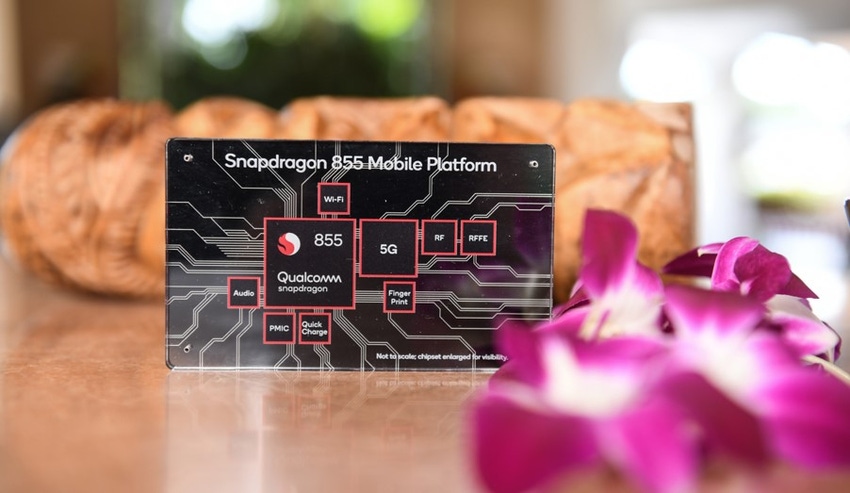More details of Qualcomm’s first 5G chipset have been released, bringing all-round improvements. 5G chipset for PCs was also announced.
December 10, 2018

More details of Qualcomm’s first 5G chipset have been released, bringing all-round improvements, and a 5G chipset for PCs was also announced.
On the first day of its annual Snapdragon Technology Summit, Qualcomm announced its 5G chipset for mobile devices, the Snapdragon 855, but released limited specs. On the following two days more details were disclosed. An SoC for 5G-connected PCs, the Snapdragon 8cx was also unveiled.
In addition to the X50 modem for 5G connectivity (on both mmWave and sub-6GHz frequencies) and X24 modem (to provide LTE connectivity), at the centre of the Snapdragon 855 is ARM’s new flagship Cortex A76 CPU, marketed by Qualcomm as Kryo 485. It contains 8 cores with the single core top performance at 2.84 GHz. Qualcomm claims the 855 is 45% faster than its predecessor 845, though it did not specify what exactly this refers to. More importantly for Qualcomm, the top speed is 9% faster than the Kirin 980 from HiSilicon (a Huawei subsidiary), another 7-nanometre implementation of the ARM Cortex A76.
Also included in the 855 is the new Adreno 640 GPU rendering graphics. Qualcomm has focused 855’s marketing messages on gaming performance, and the GPU is at the core to deliver it. Qualcomm claims the new GPU will enable true HDR gaming, as well as support the HDR10+ and Dolby Vision formats. Together with the display IP, the Adreno 640 GPU will support 120fps gaming as well as smooth 8K 360-degree video playback. Another feature highlighted is the support for Physically Based Rendering in graphics, which will help improve VR and AR experience, including more accurate lighting physics and material interactions, for example more life-like surface texture, or material-on-material audio interaction.
The key new feature on Snapdragon’s Hexagon 690 DSP is that it now includes a dedicated Machine Learning (ML) inferencing engine in the new “tensor accelerator”. The Hexagon 690 also doubles the number of HVX vector pipelines over its predecessors the Hexagon 680 and 685, to include four 1024b vector pipelines. The doubled computing power and the dedicated ML engine combined are expected to improve the Snapdragon 855’s AI capability by a big margin.
The integrated new Spectra 380 image signalling processor (ISP) will both improve the Snapdragon’s capability to deepen acceleration and to save power consumption when processing images. Qualcomm believes the new ISP will only consume a quarter of the power as its predecessor for image object classification, object segmentation, depth sensing (at 60 FPS), augmented reality body tracking, and image stabilisation.
On the OEM collaboration side, in addition to Samsung, on day 2 of the event we also saw Pete Lau, the CEO of Chinese smartphone maker OnePlus come to the stage to endorse the new 5G chipset and vow to be the “first to feature” the Snapdragon 855. Separately, the British mobile operator EE announced that it will range a OnePlus 5G smartphone in the first half of 2019.
On the same day, thousands of miles away, more Chinese smartphone OEMs including Xiaomi, OPPO, Vivo, and ZTE (in addition to OnePlus) also embraced the new Snapdragon chipset at the China Mobile Global Partner Conference in Guangzhou, southern China. China Mobile will also launch a customer premise equipment (CPE), likely a fixed wireless access modem, using the same platform.
Back in Hawaii, on day 3 of the Snapdragon Tech Summit, Qualcomm launched a new chipset for PC: the Snapdragon 8cx (“c” for computer, “x” for eXtreme). This is Qualcomm’s third iteration of chipset for PC, built on ARM v8.1 (a variant of Cortex A76). Similar to the Snapdragon 855, the 8cx also has the X24 integrated cellular modem with for LTE connectivity, and the X50 modem with 5G connectivity can be paired with it. The CPU also has eight cores, with a top speed of 2.75 GHz. The new Adreno 680 GPU is said to process graphics twice as fast as the GPU in the previous generation ARM for Windows chipset (Snapdragon 850) but 60% more efficient in power consumption.
Perhaps the most meaningful change is its memory architecture. The Snapdragon 8cx will have a 128-bit wide interface, enabling it to provide native support for much more software and applications, including Windows 10 Enterprise and Office 365, which clearly is a sales pitch to the corporate IT departments.
Unlike the OEM support garnered by Snapdragon 855, there was no public endorsement by PC makers yet. Lenovo did come to the stage but was only talking about its Yoga 2-in-1 notebooks that have used earlier generations of Snapdragon chipsets for Windows on ARM. On the other hand, Qualcomm does not position Snapdragon 8cx as a replacement for the 850 but rather as a higher end contemporary, with 850 mainly targeted at a niche consumer market.
In general, this year’s Snapdragon Tech Summit has delivered more step change with the new product launches. More concrete industry support was also on show, indicating that, depending on how fast and extensive 5G is to be rolled out, we may start seeing true 5G smartphones in the first half of next year. We may need to wait a bit longer before a reasonable line-up of always-on 5G connected PCs can hit the market.
About the Author(s)
You May Also Like








.png?width=300&auto=webp&quality=80&disable=upscale)


_1.jpg?width=300&auto=webp&quality=80&disable=upscale)


.png?width=800&auto=webp&quality=80&disable=upscale)